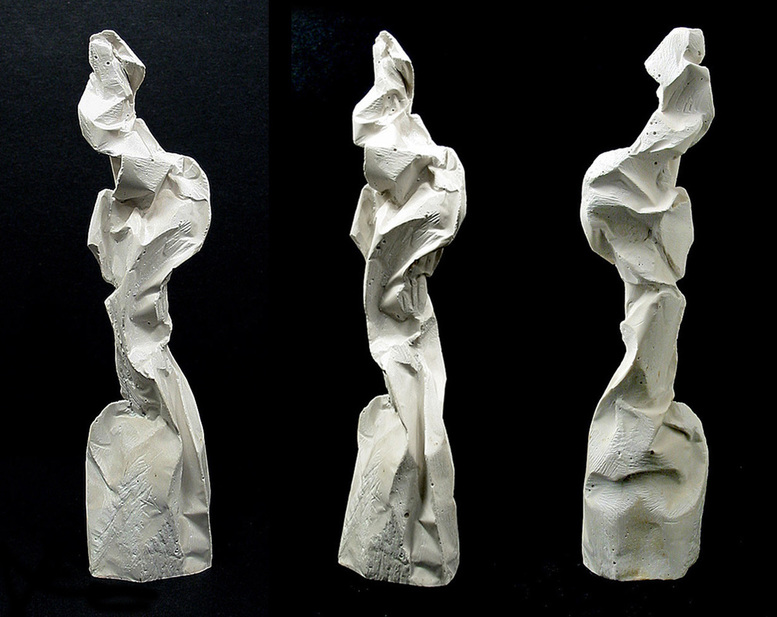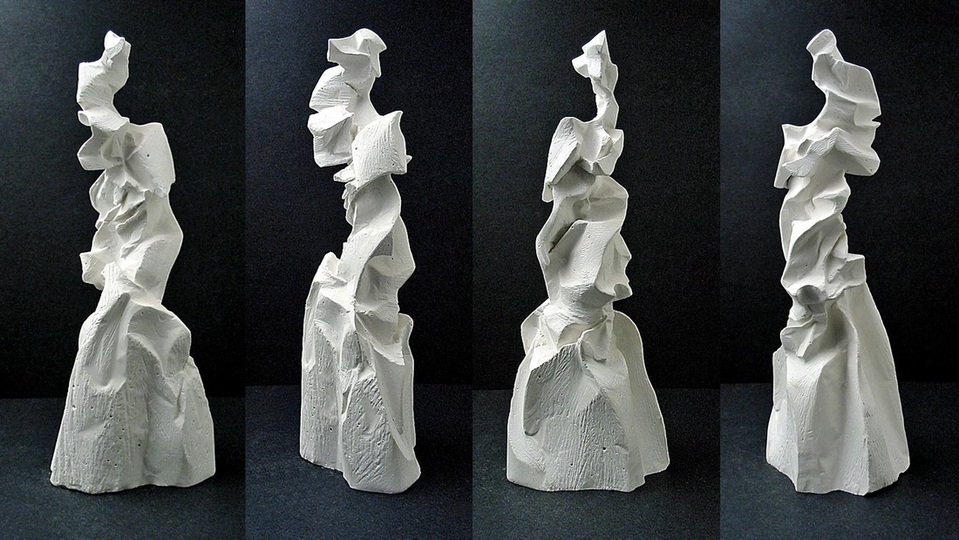COLUMNAR FIGURES IN PLASTER 2003
After working on the figurative pieces of the Nest of Dreams and the Chamber Players with all their attendant side sketches in clay, I turned again to a series of abstract works, first in plaster and then in clay.
Thin Figure 5 ¾" high (2 views)
Figure with flat head 7 ½" high (3 views)
Figure with Thrust Head 6 ¾" high (3 views)
Figure with Thrust Belly 8" high (3 views)
Cubist Figure 8 ½” high (4 views)
"Madonna" Figure 9" high (6 views)
Leaning Figure 5" high (4 views)
Wrinkled Figure 7 ½" high (2 views)
Small Squat Figure 4" high.
Small Squat Figure 4" high.
ABOUT THESE PLASTER FIGURES
I discovered the seed of the plaster series in our favorite local Japanese restaurant. I had a habit of tearing off one end of the chopsticks wrapper and crunching the remaining wrapper to the other end before removing the chopsticks. This crunched wrapper could then serve as a chopstick rest to keep the tips of the chopsticks off the table. In fancy restaurants they use ceramic rests, but we did not patronize fancy restaurants.
One time I took a couple of these crunched paper wrappers and stood them up, and they looked like tall, thin totems. I took a bunch of chopsticks home and played with their shed “skins”, finally filling some with plaster, using a bamboo skewer for inside support. When the plaster set and I peeled off the paper I had a little crinkled white column, which when set on a base reminded me of the thin, pared-down figures Giacometti struggled with around 1947-1950. My column was not, like Giacometti’s figures, a struggle to render a person in space. It was just a thin crinkled column, but it did suggest a standing figure, as such columnar shapes do.
With this as a beginning, I started making my own tubular “skins”, using aluminum foil. Keeping them on their axes by inserting a thin bamboo stick or a wooden dowel, I crinkled and distorted these skins by crunching them to one end, and then filling them with plaster. After a while the tubes got wider and the crinkled shapes more varied.
Once I removed the foil skins, several cast plaster pieces emerged. I then modified the random folded and wrinkled surfaces by carving the plaster with razor knives. So I found myself making carved figures for the first time, not from a chunk of wood or stone, but from a process of directed chance which formed the base of my figure.
I created a series of these cast-then-carved plaster pieces over a period of a month or so, all different but with a family resemblance.
With this as a beginning, I started making my own tubular “skins”, using aluminum foil. Keeping them on their axes by inserting a thin bamboo stick or a wooden dowel, I crinkled and distorted these skins by crunching them to one end, and then filling them with plaster. After a while the tubes got wider and the crinkled shapes more varied.
Once I removed the foil skins, several cast plaster pieces emerged. I then modified the random folded and wrinkled surfaces by carving the plaster with razor knives. So I found myself making carved figures for the first time, not from a chunk of wood or stone, but from a process of directed chance which formed the base of my figure.
I created a series of these cast-then-carved plaster pieces over a period of a month or so, all different but with a family resemblance.
"Baroquen Qolumn" 12 ½" high (4 views)
This was the largest plaster column I made, and it broke off at the top.
This was the largest plaster column I made, and it broke off at the top.
Though these were small, even intimate sculptures, I could envision them as large public works. As Henry Moore said, if the scale is right, a piece can hold its own when enlarged. (The full quote is in the BERKELEY section.)
The images below show five of my plaster columnar figures that I digitally inserted into photos of public sites.
The images below show five of my plaster columnar figures that I digitally inserted into photos of public sites.
Five figures envisioned as enlarged and placed in public settings. Click to enlarge.














